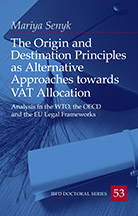| |
Pris: 1555 SEK exkl. moms  |  The origin and destination principles are the two main principles used by the OECD, EU policymakers and scholars when it comes to determining the jurisdictional reach of VAT. Although widely discussed, there is no common understanding of these principles. This not only results in confusion in the communication between legal actors, but, more importantly, can lead to different legal outcomes. Another legal issue is whether the origin and destination principles have a coercive effect: does the WTO compel its members to apply the destination principle? Can the origin and destination principles be used as a legal basis for determining taxing jurisdiction in the European Union? Yet another issue is whether consumption-type VAT may be based on the origin principle, particularly in a tax union in respect of VAT, such as the European Union. The origin and destination principles are the two main principles used by the OECD, EU policymakers and scholars when it comes to determining the jurisdictional reach of VAT. Although widely discussed, there is no common understanding of these principles. This not only results in confusion in the communication between legal actors, but, more importantly, can lead to different legal outcomes. Another legal issue is whether the origin and destination principles have a coercive effect: does the WTO compel its members to apply the destination principle? Can the origin and destination principles be used as a legal basis for determining taxing jurisdiction in the European Union? Yet another issue is whether consumption-type VAT may be based on the origin principle, particularly in a tax union in respect of VAT, such as the European Union.
This book provides a new perspective for understanding the origin and destination principles by analysing them in three international legal frameworks, namely the WTO legal order, the OECD framework and the EU legal order. Furthermore, it contains an analysis of the current and the proposed European VAT systems from the perspective of VAT allocation. One of the questions addressed in the book is whether the proposed definitive EU VAT system may be regarded as a destination-based system. At the end of the book, conclusions are presented regarding which of the two principles is preferable for the allocation of VAT in the internal market of the European Union.
This book should be of use for policymakers and other legal actors seeking to develop a deeper understanding of the origin and destination principles and their application in the internal market of the European Union. | | |
|